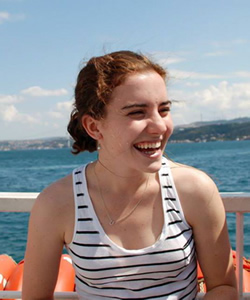Yet there are other parts that are truly remarkable, like the cliffs that shoot straight down into the Mediterranean Sea at Cleopatra Beach or the sunset behind the castle on the hill. I could spend all day in the wonderfully warm and salty water; at night, city lights below shimmer through our apartment windows.
In many ways, it’s strange to study abroad in a resort town like Alanya—to straddle the line between tourists on holiday and city residents. From my balcony, I can watch the occasional cruise ship pull into port for the day, temporarily ballooning the population of the city by several thousand, before quickly departing at 5 p.m. My runs take me to countless tourist restaurants and hotels, where leathery brown vacationers shuffle from beach to food as their main activity for the day.
In the late 1980s, Alanya experienced an intense explosion of tourists as they began to flock to its picturesque beaches, historic castle, and extensive caves. However, this huge explosion resulted in the proliferation of unplanned stretches of large-scale hotels and holiday apartments, quickly transforming this former agriculture town.
Today, Alanya has established itself as a holiday destination for tourists from Scandinavia, the Netherlands, and the United Kingdom. According to a 2006 report by the Ministry of Culture and Tourism, the greater area of Antalya receives some 10 million tourists every year. Alanya, in particular, receives over 1.8 million tourists each year, swelling its population well beyond its permanent population of over 250,000.
In conversations with our Alanyan host families, I have repeatedly been told how much Alanya has changed over the past several decades, as it grew into the city it is today. Most Alanyans work in the hospitality industry in some form, yet there exists a stark and noticeable division between the tourist and local areas.
For example, on the main streets or tourist sideways, you will find long stretches of homogeneous “tourist restaurants,” each promoting the same multilingual menu cards with a mixture of global and Turkish dishes. (Döner kebap, lasagna, and tacos all at the same place?) Inside, the restaurants will display their international collection of flags and football jerseys. Large screen televisions play all of the big football matches from around the world.
Yet these restaurants are visibly divided. Very few tourists eat where the locals go; instead, as tourists eat and drink, they only rub shoulders with other tourists. Along the main streets, you see very few locals. Even the Turkish staffs at the shops and restaurants tend to come from regions outside of Antalya.
The impact of tourism—as a driver of economic, social, cultural, and environmental change—is undeniable in a city like Alanya. Although tourism started out as a tool to promote the regional economy, troubling side effects come with such rapid urbanization.
For one, environmental impacts remain a serious concern. After a recent thunderstorm, I found myself stepping around the slew of cigarette butts and plastic bottles beached after the storm. The once pristine beaches of Alanya are now covered by never-ending rows of restaurants and hotels.
Tourism has also had a significant impact on the culture and lifestyles in Alanya, shaping its liberal atmosphere. While it might be an issue in other parts of Turkey, women can freely wear shorts and a tank top around town without a second glance. The call to prayer sounds over the pop music that blasts near the beach.
Nevertheless, this experience with “Tourist Turkey” has made me wonder: where’s the real Turkey? How can you find authenticity amidst banal internationalization?
Luckily, it does exist in Alanya, if you search for it. It endures back away from the tourist thoroughfares and in the apartments of local families. It persists in sharing the celebration of Bayram with the many relatives of our host families; it appears when I manage to squeeze out a few words of Turkish for a conversation.
Sometimes, you simply must wander outside of the souvenir shops.

